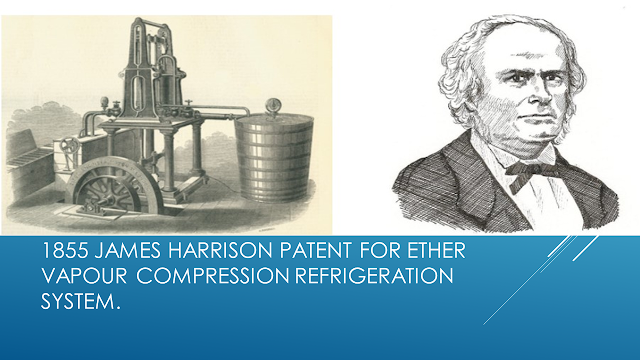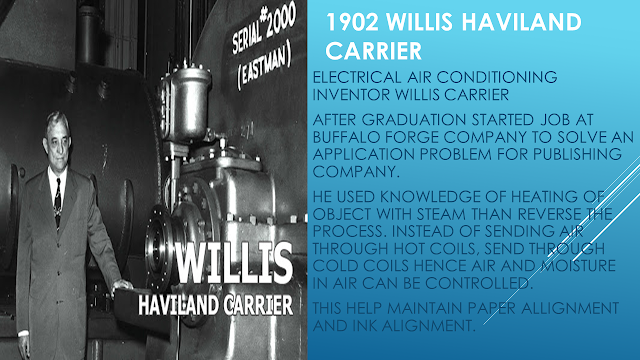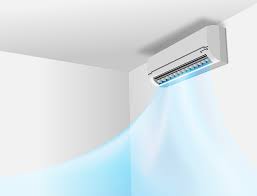HISTORY OF AIR CONDITIONER
In this 21st
century air conditioner plays a vital role to enhance the growth and develop of
the nation. Air conditioner has a major role in variety of sectors, this invention
was enrolled in the name of preservation of the food for longer time.
Hence the food preservation break
down towards the growth of the air conditioner ,with the help of various principles
put forward by scientist and great thinker.
The history of air
conditioner started in the early days with the need to preserve foods. Foods
that are kept at room temperature spoil easily due to the growth of bacteria. At
temperature below 4°C (40°F), the growth of bacteria is reduced rapidly.
Air conditioner is one of
the most important inventions which has remarkable resemblance in the world
history.
From cooling and preservation
of food, the invention too inclined towards comfort conditioning for humans.
cooling
homes, business sectors ,and industrial sectors are one of the most important
aspect of the growth and development.
Well human comfort is
directly proportional to quality of work
,sleep and life which stands one of the most appreciated proposal by everyone.
Well today we are getting
the comfortable temperature in on trigger or by pressing or click on the
buttons ,but do you know how this comfort making machine came into picture?
What was the history of the air-conditioning?
Who invented air conditioning ?
So lets begin with this how
it come into evidence to the human.
Well in prehistoric times
there was no sort of cooling pleasure available to humans either for human
comfort nor for food preservation.
Since prehistoric times , snow and ice were used
for cooling hence it was harvested in winter and stored for summer became
popular in late 17 th century.
Well there the people from different region used
their tricks to cool the surrounding by natural process .
Basic concept of AC was applied by Egyptian , who
used to hung the grass in windows and were sprinkled with water, hence the
evaporation of water cooled the air blowing through the window and Persian used cooling towers to cool the buildings.
DING HUAN
Well in 2nd century
Chinese mechanical engineer, inventor and craftsman DING HUAN contributed a evaporation cooling
methods which sparked up the cycle for innovation in the world history of air
conditioner cooling.
He invented and crafted a
rotary fan of 3 meter diameter which was operated manually by using jet streams
of water for cooling effect.
Which played a vital role
in cooling various places and was subjected to cooling environment .
CORNELIS DREBBEL
In the 17th century, the Dutch inventor Cornelis Drebbel demonstrated Turning Summer
into Winter as an early form of modern air conditioning for James I of England by adding salt to water.
Involvement of chemistry
IN 1758, BENJAMIN FRANKLIN AND JOHN HADLEY CHEMISTRY PROFESSOR AT CAMBRIDGE UNIVERSITY
CONDUCTED EXPERIMENT OF EVAPORATION OF HIGHLY VOLATILE
LIQUID (ALCOHOL AND ETHER) FOUND EVAPORATES FASTER THAN WATER AND COOLS THE
OBJECT UP-TO FREEZING POINT.
CONDUCTED
ON MERCURY BULB THERMOMETER AS A OBJECT AND CONTINUE TILL -14 DEGREE.
This chemistry technique of
fast evaporation paved the way of inorganic cooling over the organic cooling.
Discovery of chemical which
has faster evaporation rate open the doors for cooling at faster rates.
This experiment proved that
the cooling can be achieved till the formation of ice irrespective of organic
process of cooling.
Franklin concluded: "From this experiment
one may see the possibility of freezing a man to death on a warm summer's day."
In
1820, English scientist and inventor Michael Faraday discovered
that compressing and liquefying ammonia could chill air when the liquefied ammonia was allowed
to evaporate.
The discovery of the principles of the absorption type of refrigeration
in 1824 showed that liquefied ammonia could chill air when it is
allowed to evaporate. Ice was created using compressor technology
This principle is also applied in today's air conditioning system which has a
foundation of vapour compression refrigeration cycle.
He contributed
towards the foundation of vapour compression cycle.
In the 1840s, physician and
inventor Dr. John Gorrie of Florida proposed the idea of cooling cities to
provide comfort condition by overcoming the high temperature.
Gorrie believed
that cooling will avoiding diseases like malaria and making patients more
comfortable, but for cooling his hospital rooms, required ice which has to
be shipped to Florida from frozen lakes and streams in the northern United
States.
To get rid of expensive
logistical issue, Gorrie began to work with the concept of artificial
cooling. He designed a machine that created ice using a compressor
powered by a horse, water, wind-driven sails or steam and was granted a
patent for it in 1851.
Although Gorrie was unsuccessful at bringing his
patented technology to the marketplace -- primarily due to the death of his
chief financial backer -- his invention laid the foundation for modern air conditioning
and refrigeration.
JAMES HARRISON
James Harrison was
a British Australian newspaper
printer, journalist, politician, and pioneer in the field of mechanical refrigeration.
His
first mechanical ice-making machine began operation in 1851. His first
commercial ice-making machine followed in 1853, and his patent for an ether vapour compression refrigeration system was granted in 1855.
This system used a compressor to force the refrigeration gas to pass
through a condenser, where it cooled down and liquefied. The liquefied gas then
circulated through the refrigeration coils and vaporised again, cooling down
the surrounding system. The machine produced 3000 KG of ice per day.
Willis Haviland Carrier
The commercially available
of air conditioning applications started based on the need to cool air for
industrial processes than for personal comfort.
The first electrical air
conditioning was invented by Willis Haviland Carrier in the year 1902. He was
also known as the Father of Modern Air Conditioning.
After graduation he started
job at buffalo forge company to solve application problem of publishing
company.
Well he found that due to
humidity the printing product was not satisfactory due to unaligned prints and rapture
quality which was less pleasing.
He was sitting on the bench
at railway station early in the morning full of foggy environment around him.
The Idea struct to him and he build a device by using his knowledge of the heating of objects with steam
and reversed the process.
Instead of sending air through hot coils, he sent it through
cold coils (filled with cold water). The air was cooled, and thereby the amount
of moisture in the air could be controlled, which in turn made the humidity in
the room controllable. The controlled temperature and humidity helped maintain
consistent paper dimensions and ink alignment.
Through
a series of experiments, Carrier designed a system that controlled humidity
using cooling coils and secured a patent .
which could either humidify
(by heating water) or dehumidify (by cooling water) air.
As he
continued testing and refining his technology, he also devised and patented an
automatic control system for regulating the humidity and temperature of
air in textile mills.
His invention was designed to improve the manufacturing process of a
printing plant.
By controlling the temperature and humidity of the plant, the
processes were made more efficient as the paper size and the
ink alignment were consistently maintained.
It
wasn't long before Carrier realised that humidity control and air conditioning
could benefit many other industries, and he eventually broke off from Buffalo
Forge, forming Carrier Engineering Corporation with six other engineers.
The Carrier Air Conditioning Company of America was established by him
to meet the demand of better productivity in the workplace.
Today, Carrier
Corporation is the biggest air conditioner manufacturer and marketing
corporation in the world in central air conditioning.
In May 1922 at Rivoli Theatre
in New York, Carrier publicly debuted a new type of system that used a
centrifugal chiller.
The system increased the
reliability and lowered the cost of large-scale air conditioners, and expanding
their use throughout the country.
With advancement in air
conditioning there was still the lack of compactness and inexpensiveness which
was barking out loudly towards its advancement.
In 1929 Frigidaire showcase
his new split system or room cooler which address towards compactness but
lacks again in costs and weight.
Than General Electric's Frank Faust improved on this
design, developing a self-contained room cooler, and General Electric ended up
producing 32 similar prototypes from 1930 to 1931.
Around
this same time, Thomas Midgley, Albert Henne and Robert McNary of General
Motors bring out chlorofluorocarbon (CFC) coolants into picture, which became
the world's first non-flammable refrigerating fluids, substantially improving
the safety of air conditioners.
However,
the chemicals was dangerous towards ozone depletion decades later and were
eventually phased out by governments all across the globe after
the Montreal Protocol in the 1990s.
Hydrofluorocarbons
(HFCs), which don't destroy the ozone, gain popularity but are
eventually linked to climate change.
Residential
cooling systems got compact after H.H. Schultz and J.Q. Sherman filed a patent
for an air conditioning unit that could be placed on a window space. The units was
introduce in the market in 1932 but were not widely purchased due to their high
cost.
Engineer
Henry Galson went on to develop a more compact, inexpensive version of the
window air conditioner which let the pleasure to utilize the cooling system.
Well many
of you might have questioned why such cooling device is named as AIR CONDITIONER?
Why is it called an air conditioner?
Shortly after Willis
Carrier designed his cooling machine, Stuart W. Cramer invented
a similar device to add moisture to the stuffy air in his textile plant. Cramer
was the first to use the term “air conditioning”, inspired by the idea of “water
conditioning”, a then-popular textile making process.
But why is it called an air conditioner, not
an air cooler? The answer is quite evident: even though AC units have always
been used predominantly to cool down air, their dehumidification properties
were precisely why Carrier and Cramer set about inventing them.
IT NOT ONLY COOL BUT it CONDITIONS the air by removing
excess moisture, making the atmosphere in your home as comfortable as can
be. Hence it is called as air conditioning.
Well this was the contribution by the legends due to which we are enjoying a very comfortable life. Not only this , but studies have changed the era of both human comfort along with machine cooling and preservation of food.
well we neglect the air conditioning contribution but this field always focus on contribution to society rather than accepting the gratitude.
Thanks for reading hope you like the article.
If you want to add something you can mention on the comment box..........









please don`t enter any spam link in the comment box ConversionConversion EmoticonEmoticon